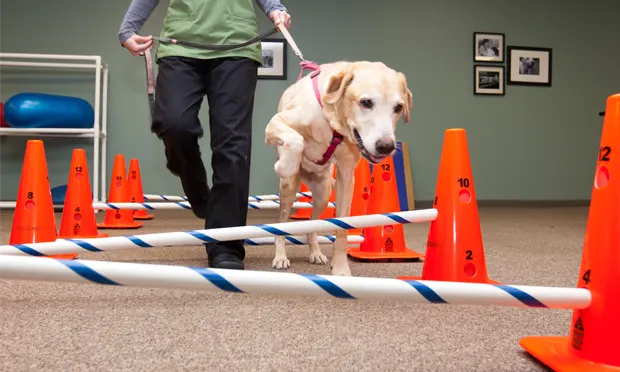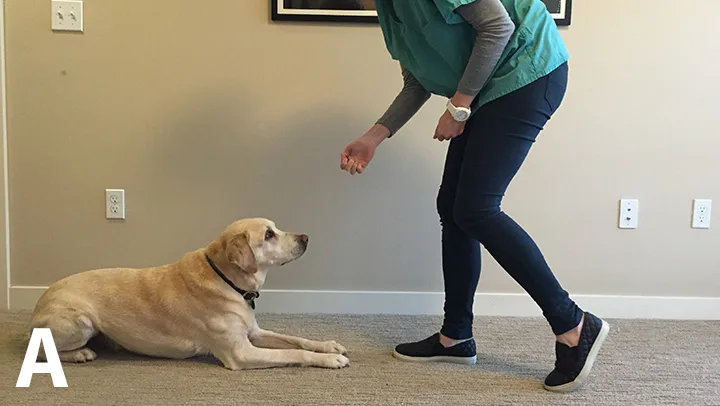5 Essential Therapeutic Exercises for Dogs with Osteoarthritis

Veterinary physical rehabilitation encompasses a whole-body approach to patient assessment and treatment, and the foundation of treatment is therapeutic exercise. The types of exercises prescribed are determined based on the injuries or diseases present, surgery (if any) performed, functional abilities and disabilities, and assessment of axial muscle strength, core strength, proprioception, and joint range of motion (ROM).1-3
Dogs with osteoarthritis benefit from strengthening the muscles supporting an arthritic joint, maintaining and improving active ROM of all joints, strengthening the core muscles, and maintaining or improving proprioception and balance.4,5 The following are 5 basic therapeutic exercises that may be prescribed for dogs with osteoarthritis. The client may perform these exercises as part of a home-exercise plan, but the veterinary technician plays the crucial role of instructing the client on proper exercise performance.

Sit-to-Stand
This exercise is prescribed for improving or maintaining muscular strength and active hind-limb ROM. The key to success is ensuring that the dog flexes the stifles and tarsi of both limbs fully so that the limbs are both tucked in a normal position against the body.
A dog asked to stand should use both back legs to move to the standing position. For dogs that sit to one side, with the contralateral hind limb held away from the body, the client or assistant should stand behind the dog and use his or her feet to scoot the dog’s back legs into a tucked position. That person remains behind the dog while a second person stands in front and asks the dog to stand. Reward the dog each time (and only if) it sits square and stands with both limbs. Start with 3 to 5 repetitions several times a day and gradually work up to 3 sets of 10 to 12 every day.
Down-to-Stand
This exercise is also prescribed for improving or maintaining muscular strength and active hind-limb ROM and is particularly useful for strengthening the gluteal muscles. Down-to-stand can be a beginning-level core-strengthening exercise.
Ask the dog to move to a down position. Ensure that both back limbs are tucked against the body and the dog is in a sphinx position. Stand in front, facing the dog with a treat.
The key to success with this exercise is to take a step back from the dog while asking it to stand so that it moves directly from a down-to-stand position without sitting in between. To advance this exercise and engage the core muscles, the dog should move from down to stand and back down again without taking any steps forward or backward (the feet stay in the same position while the body moves over them). Start with 3 to 5 repetitions several times a day and gradually work up to 3 sets of 10 to 12 every day.

Three-Leg Standing

This exercise, which is prescribed for improving muscular strength in a weak limb by encouraging isometric muscle contraction, is also is a beginning-level exercise for improving core strength and balance.
Lift the dog’s leg on the opposite side of the weak limb (ie, lift the left rear leg if the right rear leg is being targeted for strengthening; lift the right front limb if the left front is being targeted). Extend the leg slightly back if hind-limb or forward if front-limb so that the dog cannot bear weight through the hand. Hold the leg off the ground for 5 to 10 seconds and then allow the dog to stand on all 4 limbs to rest. Repeat 3 to 5 times a day. Work up to holding the limb off the ground for 30 seconds, 8 repetitions, 3 times a day. If multiple limbs are weak, repeat the exercise targeting each weak limb.
Cross-Leg Standing
This exercise, also known as 2-leg standing or bird-dog, is prescribed for improving core muscular strength and balance. It is an advanced form of the 3-leg standing exercise to increase a weak limb’s muscular strength.
Lift one front leg and the contralateral hind leg, allowing the dog to stand on 2 legs. Extend the front leg forward and the rear leg back. Hold the leg off the ground for 5 to 10 seconds and then allow the dog to stand on all 4 limbs to rest. Repeat 3 to 5 times a day. Work up to holding the limbs off the ground for 30 seconds, 8 repetitions, 3 times a day. Repeat with the opposite 2 legs.
For an advanced exercise, wiggle the 2 legs that are off the ground to challenge balance and core stability. The dog should be able to stand on 2 legs for approximately 30 seconds before trying this exercise.

Cavaletti Rails, High-Stepping, or Obstacle Course
This exercise is prescribed for improving cardiovascular endurance, proprioception, and active ROM and muscular strength in all limbs.
To perform this exercise, place 6 cavaletti rails, spaced as far apart as the dog’s shoulder height. The bars’ height should be based on the dog’s size and the joints targeted for improving flexion. For example, setting the bars at the height of the dog’s carpi can target stifle and tarsal flexion. The bars can be set at the level of the elbow for targeting elbow flexion. Walk the leashed dog slowly so that it steps over each rail with individual limbs rather than hopping. Walk back and forth 3 times. Work up to 6 times back and forth.
For an added challenge, change the height of the rails and add diagonal positions (one side of a rail higher than the other). For an advanced challenge, place the cavaletti rails on a hill.
If cavaletti rails are not available, walk the dog through tall grass so that each hind limb is lifted and flexed at the hip, elbow, and carpus, or create an obstacle course with objects the dog will not step on (eg, brooms, water noodles, pillows, toys). Walk the dog over the course so that it must high step or pick up its legs fully to move over the objects. Walking up and down hills and stairs can also improve range of motion.2,3
Conclusion
While therapeutic exercises are an important part of the compressive treatment of osteoarthritis, it is crucial that a full orthopedic examination be performed by a veterinarian prior to recommending these exercises. The veterinarian should rule out other causes of lameness and pain, including bone and nerve-root tumors and neurologic disease, and ensure that pain is well managed. Training and certification in canine rehabilitation therapy will enable interested veterinarians and technicians to provide addition manual and exercise therapies for dogs with osteoarthritis.